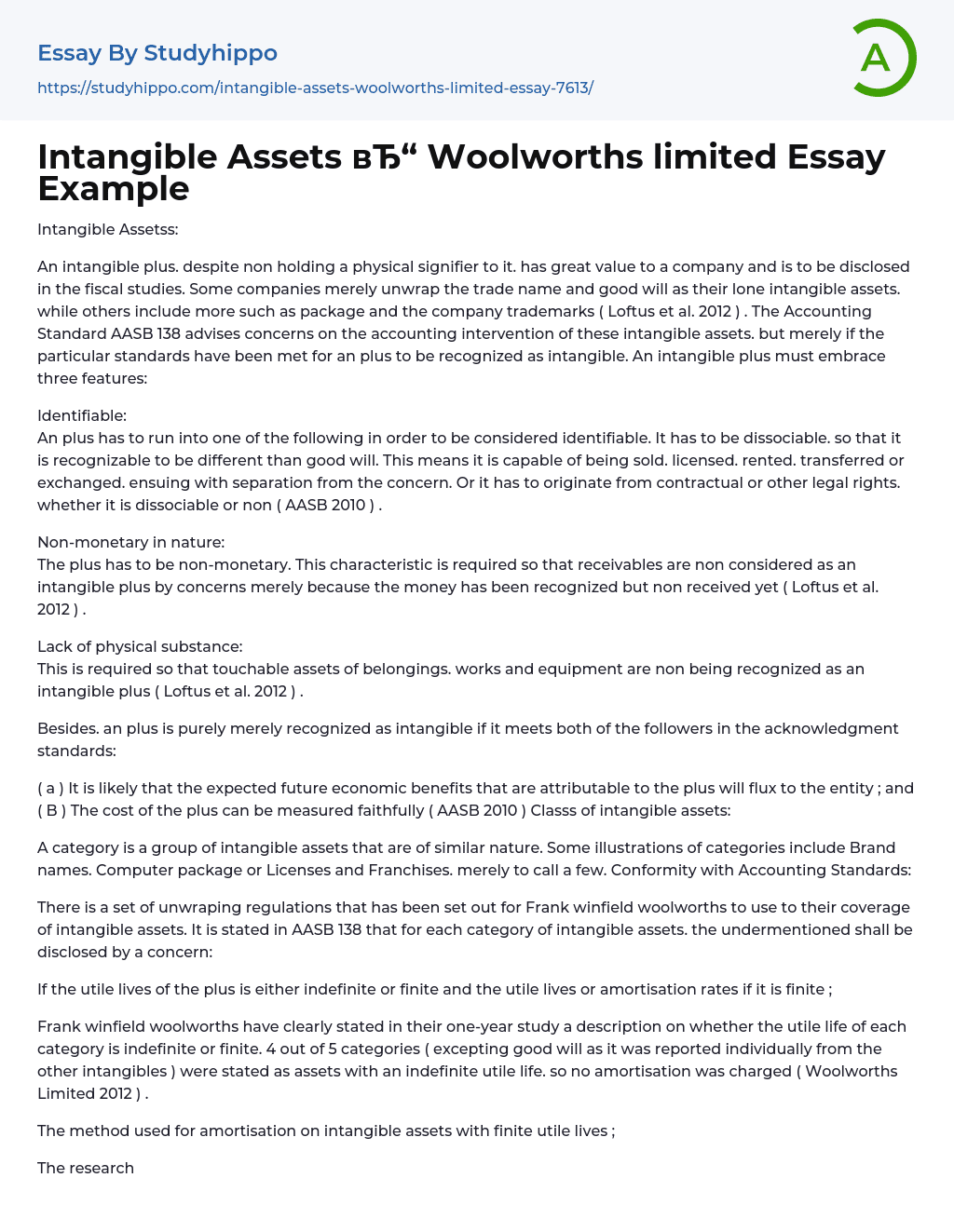Intangible assets, despite lacking physical form, hold significant value for companies and must be disclosed in financial reports (Loftus et al., 2012). The Accounting Standard AASB 138 provides guidance on how to account for these assets, but only if certain criteria are met (AASB 2010). An intangible asset must meet three characteristics: it must be identifiable, non-monetary in nature, and lack physical substance (Loftus et al., 2012). Identifiability can be achieved through separability or contractual/legal rights. Non-monetary nature ensures that receivables are not classified as intangible assets solely based on recognition. Lastly, the lack of physical substance excludes tangible assets from being considered intangible assets (Loftus et al., 2012).An intangible asset is considered as such if it meets two criteria: firstly, there is a likelihood that the future economic benefits of the asset will flow to the entity, and
...secondly, the cost of the asset can be accurately measured (AASB 2010). Intangible assets can be categorized based on their nature, including brand names, computer software, licenses, and franchises. Accounting standards require businesses like Woolworths to disclose specific information for each category of intangible assets. This includes indicating whether the useful life of the asset is indefinite or finite and providing details on amortization rates in case of finite useful life. In its annual report, Woolworths confirms that four out of five categories have indefinite useful lives and therefore no amortization was charged. The method used for amortizing intangible assets with finite useful lives is also disclosed by Woolworths Limited (2012). Within Woolworths Limited's research and development category of intangible assets, there is a specific rule applied. Any expenses incurred on development activities that apply researc
findings to create a new or improved product are capitalized if the program is deemed commercially feasible and sufficient company resources are available to complete it. These capitalized expenses are recorded as cost less accrued amortization and impairment losses (Woolworths Limited 2012). However, specific amortization rates were not defined by Woolworths Limited.The financial report from Woolworths Limited in 2012 provided information on the gross carrying amount, accrued amortization, and impairment losses at the beginning and end of the period. It also included details of where any amortization of intangible assets was recorded in the statement of comprehensive income. The report presented each category of intangible asset separately with their respective amounts, making it easier to identify amortization and impairment losses. This fulfilled the requirement stated by Standards (AASB 138) to provide a reconciliation of carrying amounts at the beginning and end of the period. In accordance with AASB 138, Woolworths Limited disclosed their intangible assets, which were non-monetary and lacked physical substance, following acquisitions and disposals in their financial statements for both 2011 and 2012. Although limited information was provided about amortization rates for these assets, Woolworths adhered to relevant accounting standards in their reports. Overall, it is suggested that AASB 138 already mandates companies to comprehensively evaluate and disclose their intangible assets in financial statements.
The text proposes that the guidelines should specify the type and location of report where information should be disclosed, in order to make it more accessible. This recommendation is based on AASB 2010 and AASB 138 - Intangible Assets. Various resources are available including a document named "AASB138_07-04_ERDRjun10_07-09.pdf" on the AASB website, a book called "Understanding Australian Accounting Standards" by
Loftus, Leo, Picker, Wise, and Clark, as well as the 2012 financial report for shareholders of Frank Winfield Woolworths Limited which can be found on the Woolworths Limited website. Additionally, there is an appendix labeled "Appendix 1".
- Accounts Receivable essays
- Auditor's Report essays
- Balance Sheet essays
- Costs essays
- Financial Audit essays
- International Financial Reporting Standards essays
- Tax essays
- Accountability essays
- Cash essays
- Principal essays
- Management Accounting essays
- Internal Control essays
- Accounting Software essays
- Cash Flow essays
- Net Present Value essays
- Income Statement essays
- Accounting essays
- Andrew Carnegie essays
- Automation essays
- Business Cycle essays
- Business Intelligence essays
- Business Model essays
- Business Operations essays
- Business Software essays
- Cooperation essays
- Cooperative essays
- Corporate Social Responsibility essays
- Corporation essays
- Customer Relationship Management essays
- Family Business essays
- Franchising essays
- Harvard Business School essays
- Harvard university essays
- Human Resource Management essays
- Infrastructure essays
- Inventory essays
- Logistics essays
- Management essays
- Manufacturing essays
- Market essays
- Marketing essays
- Multinational Corporation essays
- News Media essays
- Online Shopping essays
- Quality Assurance essays
- Richard Branson essays
- Sales essays
- Selling essays
- Shopping Mall essays
- Small Business essays




